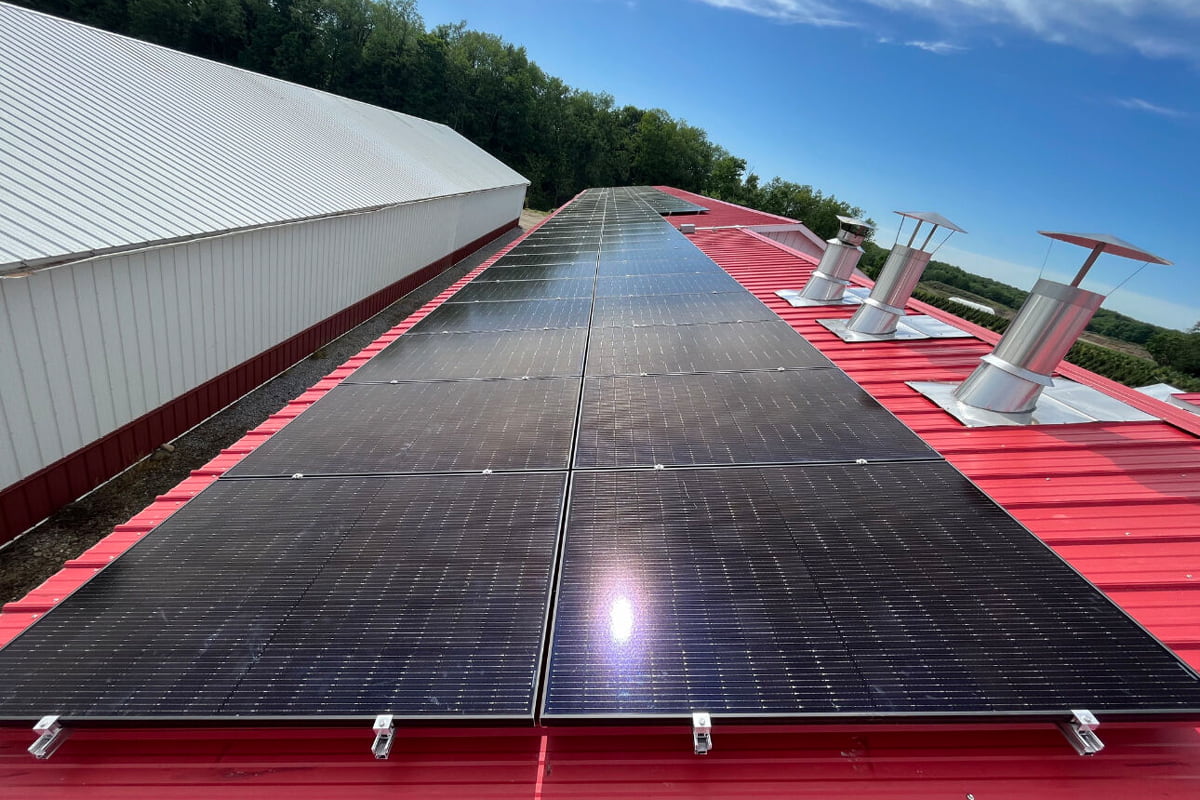µ£Ćķ½śµĖ®49Ōäā’╝üÕģēõ╝ÅÕÅæńöĄÕÅæĶ┤óõ║å’╝¤Ķ░ŻĶ©Ć’╝ü
Jul 05, 2024
õ╗ŖÕ╣┤5µ£łõ╗źµØź’╝īÕŹ░Õ║”ķüŁķüćÕÅ▓µŚĀÕēŹõŠŗńÜäńāŁµĄ¬’╝īÕżÜÕ£░µ░öµĖ®ĶČģĶ┐ć45ŌäāŃĆéķ”¢ķāĮµ¢░ÕŠĘķćīõĖĆÕ║”ÕĮĢÕŠŚ52.9ŌäāńÜäµ×üń½»ķ½śµĖ®ŃĆéĶÖĮńäČÕÉÄµØźĶ»üÕ«×µś»ĶÖܵāŖõĖĆÕ£║’╝īµĢ░µŹ«µ»öÕ«×ķÖģµ░öµĖ®ķ½śÕć║3Ōäā’╝īõĮåµÄźĶ┐æ50ŌäāńÜäµ░öµĖ®ĶČ│õ╗źĶć┤ÕæĮŃĆéÕÉīµŚČ’╝īÕŹ░Õ║”õĖ£ķā©µ»öÕōłÕ░öķé”ÕĘ▓µ£ē14õ║║ÕøĀķ½śµĖ®µŁ╗õ║ĪŃĆé
õ╗Äõ║ܵ┤▓ńÜäµ¢░ÕŠĘķćī’╝īÕł░ķØ×µ┤▓ńÜäÕĘ┤ķ®¼ń¦æ’╝īÕåŹÕł░ńŠÄµ┤▓ńÜäÕó©Ķź┐ÕōźÕ¤ÄŃĆüµŗēµ¢»ń╗┤ÕŖĀµ¢»’╝īĶ«ĖÕżÜÕ¤ÄÕĖéķāĮńéÄńāŁķÜŠĶĆÉŃĆé
µ×üÕ║”ńéÄńāŁńÜäÕż®µ░ö’╝īķÜŠõ╗źÕģŗµ£ŹńÜäõĖŹõ╗ģõ╗ģµś»ńāłµŚźńéÄńéÄ’╝īķ½śµĖ®ÕĮ▒ÕōŹõĖŗńÜäńöĄÕŖøõŠøÕ║öõ╣¤ÕŹüÕłåń┤¦Õ╝ĀŃĆéńäČĶĆīµ£ēõ║║õĖŹń”üń¢æµāæ’╝īķ½śµĖ®õĖŹµŁŻµś»Õģēõ╝ÅÕÅæńöĄńÜäÕźĮµŚČµ£║ÕÉŚ’╝¤Õģēõ╝ÅńöĄń½ÖÕ▓éõĖŹµś»ĶĄÜÕż¦ķÆ▒õ║å’╝¤
Õ»╣õĖŹĶĄĘ’╝īĶ┐Öµ¼ĪõĖŹõĮåń£¤ńÜäÕŠłńāŁ’╝īõĮĀõ╣¤ń£¤ńÜäÕŠłŌĆ£Õż®ń£¤ŌĆØŃĆé
ńéÄńāŁµÖ┤Õż®µś»Õģēõ╝ÅÕÅæńöĄńÜäÕźĮµŚČµ£║ÕÉŚ’╝¤
Õģēõ╝ÅÕÅæńöĄńÜäÕĤńÉå’╝īµ£¼Ķ┤©õĖŖµś»Õł®ńö©Õģēńģ¦Õ░äÕŹŖÕ»╝õĮōõ║¦ńö¤ńÜäÕģēńö¤õ╝Åńē╣µĢłÕ║ö’╝īÕ░åÕģēĶāĮĶĮ¼Õī¢õĖ║ńöĄĶāĮŃĆéÕ¤║õ║ĵŁż’╝īÕŠłÕżÜõ║║µÖ«ķüŹĶ«żõĖ║’╝īµŚźńģ¦Õ╝║ńÜäńéÄńāŁÕż®µ░öµø┤µ£ēÕł®õ║ÄÕģēõ╝ÅĶ«ŠÕżćÕÅæńöĄ’╝īńéÄńāŁÕż®µ░öķś│ÕģēĶČŖÕģģĶČ│’╝īÕÅæńÜäńöĄĶČŖÕżÜŃĆé
õĮåµĖ®Õ║”ķ½śÕ╣ČõĖŹµäÅÕæ│ńØĆÕģēĶāĮÕ░▒ÕżÜŃĆé
ńöÜĶć│Õż¬ķś│ĶāĮńöĄµ▒ĀµØ┐ńÜäÕŖ¤ńÄćõ╣¤õ╝ÜķÜÅńØƵĖ®Õ║”ńÜäÕŹćķ½śĶĆīõĖŗķÖŹ’╝īõ╣¤Õ░▒µś»Ķ»┤µĖ®Õ║”ĶČŖķ½ś’╝īÕģēõ╝Åń╗äõ╗ČńÜäĶŠōÕć║ÕŖ¤ńÄćÕ░▒ĶČŖõĮÄŃĆé
Õ«×ķÖģõĖŖ’╝īÕģēõ╝ÅńöĄń½Öµ£ĆõĮ│ÕÅæńöĄµĖ®Õ║”õĖ║23Ōäā~24Ōäā’╝īÕĮōµĖ®Õ║”õĖ║20ŌäāµŚČ’╝īń╗äõ╗ČńÜ䵣ŻÕĖĖÕĘźõĮ£µĖ®Õ║”Õ£©45ŌäāÕĘ”ÕÅ│’╝øÕ£©µ×üń½»ķ½śµĖ®µØĪõ╗ČõĖŗ’╝īń╗äõ╗ȵĖ®Õ║”ÕÅ»ķ½śĶŠŠ85Ōäā’╝īÕåģķā©ńöĄµ▒ĀńÜäÕĘźõĮ£µĖ®Õ║”ÕÅ»ĶāĮµø┤ķ½śŃĆé
ÕģĘõĮōµØźĶ»┤’╝īÕż¬ķś│ĶāĮńöĄµ▒ĀµØ┐õĖĆĶł¼µ£ēõĖēõĖ¬µĖ®Õ║”ń│╗µĢ░’╝īÕ╝ĆĶĘ»ńöĄÕÄŗŃĆüÕ│░ÕĆ╝ÕŖ¤ńÄćÕÆīń¤ŁĶĘ»ńöĄµĄüŃĆéõ╗źÕ│░ÕĆ╝ÕŖ¤ńÄćõĖ║õŠŗ’╝īµĖ®Õ║”µ»ÅõĖŖÕŹć1Ōäā’╝īÕÅæńöĄķćÅń║”õĖŗķÖŹ0.36%ŃĆé
µŁżÕż¢’╝īÕ£©ķ½śµĖ®õĖŗ’╝īÕ╝ĆĶĘ»ńöĄÕÄŗõ╣¤õ╝ÜÕż¦Õ╣ģõĖŗķÖŹ’╝īÕĮ▒ÕōŹń╗äõ╗ȵƦĶāĮŃĆéµ£ēńĀöń®ČĶĪ©µśÄ’╝īµĖ®Õ║”Õ£©20ŌäāÕĘ”ÕÅ│µŚČń╗äõ╗ČńÜäĶŠōÕć║ÕŖ¤ńÄćĶ”üķ½śõ║Ä70ŌäāµŚČŃĆéÕøĀµŁż’╝īÕŹ│õĮ┐Õģēńģ¦µØĪõ╗ČõĖĆĶł¼’╝īõĮĵĖ®Õ£░Õī║ńÜäÕÅæńöĄķćÅÕÅ»ĶāĮĶ”üĶ┐£ķ½śõ║ÄÕģēńģ¦Õ╝║õĮåµĖ®ŌĆŗŌĆŗÕ║”ĶŠāķ½śńÜäÕ£░Õī║ŃĆé
As one of the main components of photovoltaic power generation, the working environment temperature of the photovoltaic inverter is relatively high, so the inverter is generally installed at a high place with shade and ventilation, and the solar inverter installed outdoors will be equipped with a sunshade cover, and the inverter must be kept ventilated.
Similarly, the components in the photovoltaic inverter also have a rated operating temperature. If the ambient temperature is too high, the temperature of the inverter will rise quickly when it is running at full power. When the operating temperature of the photovoltaic inverter exceeds the threshold, the output power will be limited, and even over-temperature standby protection will be triggered, which will accelerate the aging of the inverter components, affect the life of the photovoltaic power station, and increase the operation safety risk of the power station.
Simply put, high temperatures will significantly reduce the power generation efficiency of photovoltaic panels. If it is too hot, photovoltaic equipment cannot stand it.
High temperature can easily cause photovoltaic "heat stroke"
In addition, under high temperature, photovoltaic equipment will also produce hot spot effect and PID effect and other effects.
The hot spot effect refers to the fact that some components in the series branch are "shielded" for some reasons. Not only can they not generate electricity, but they will also be used as loads to consume the energy generated by other branches. Once a hot day occurs, the local temperature will be aggravated, strengthening the hot spot effect, directly leading to the aging and damage of the component panels.
As a "big board" exposed to the outdoors, it is inevitable that it will be contaminated, such as bird droppings, dust, etc. In normal times, bird droppings will cause a small resistance. Once high temperature occurs, it will aggravate the impact it brings, and it is very easy to burn out the components.
Like some rooftop distributed photovoltaics, hot spots cause local temperatures to rise rapidly, which can easily cause fire accidents. In recent years, fire accidents caused by hot spots have occurred from time to time. Timely maintenance and cleaning can largely avoid danger.
In addition, the PID effect (potential induced decay) will also be aggravated with high temperature and humid environment.
ńö▒õ║Äķ½śµĖ®ÕŠĆÕŠĆõ╝┤ķÜÅńØƵĮ«µ╣┐’╝īõ╗źõĖ£ÕŹŚµ▓┐µĄĘÕ¤ÄÕĖéõĖ║õŠŗ’╝īÕżÅÕŁŻµŁŻÕĆ╝µóģķø©ÕŁŻĶŖé’╝īÕż¦ķćÅńÜäķø©µ░┤õ╝┤ķÜÅńØĆķ½śµĖ®’╝īõĮ┐ÕŠŚµĢ┤õĖ¬ń®║µ░öńÄ»ÕóāÕ”éÕÉīĶÆĖń¼╝õĖĆĶł¼’╝īµŁżµŚČń®║µ░öõĖŁÕż¦ķćÅńÜäµ░┤µ▒ĮÕ░▒õ╝ÜķĆÜĶ┐ćÕ░üĶŠ╣ńĪģĶāȵł¢ĶĆģĶāīµØ┐Ķ┐øÕģźń╗äõ╗ČÕåģķā©’╝īÕ»╝Ķć┤ń╗äõ╗ČÕåģķā©Õż¦ķćÅńÜäńöĄĶŹĘÕĀåń¦»Õ£©ńöĄĶŖ»ĶĪ©ķØó’╝īķĆĀµłÉõĖźķćŹńÜäµĆ¦ĶāĮõĖŗķÖŹŃĆé
ķ½śµĖ®µØĪõ╗ČõĖŗÕģēõ╝ÅńöĄń½ÖĶ┐ÉĶĪīń╗┤µŖżµīćÕŹŚ
1.µĖģµ┤üÕģēõ╝Åń╗äõ╗ȵś»Õģ│ķö«
ńö▒õ║ÄÕģēõ╝ÅĶ«ŠÕżćÕ£©ķ½śµĖ®õĖŗõ╝Üõ║¦ńö¤ńāŁµ¢æµĢłÕ║ö’╝īķ½śµĖ®õĖŗńü░Õ░śŃĆüķĖ¤ń▓¬ńŁēµ▒Īńē®µø┤Õ«╣µśōķÖäńØĆÕ£©ń╗äõ╗ČĶĪ©ķØó’╝īõĖŹõ╗ģÕĮ▒ÕōŹÕÅŚÕģēµĢłµ×£’╝īĶ┐śÕ«╣µśōÕ╝ĢÕÅæńü½ńüŠŃĆéÕøĀµŁżķ£ĆĶ”üÕó×ÕŖĀµĖģµ┤üķóæńÄć’╝īõĮ┐ńö©ĶĮ»ÕłĘÕÆīµĖģµ░┤µĖģµ┤Ś’╝īÕ░ĮķćÅõ┐ØĶ»üń╗äõ╗ČĶĪ©ķØóÕģēµ╗æՔ鵢░ŃĆé
2. õ┐صīüĶ«ŠÕżćķĆÜķŻÄÕŠłķćŹĶ”ü
Õģēõ╝Åń╗äõ╗ČŃĆüķĆåÕÅśÕÖ©ŃĆüķģŹńöĄń«▒ńŁēÕżäÕ┐ģķĪ╗ķĆÜķŻÄ’╝īõ┐ØĶ»üń®║µ░öµĄüķĆÜŃĆé
ńöĄń½ÖĶ«ŠÕżćÕ«╣µśōÕÅæńāŁ’╝īÕĮ▒ÕōŹĶ┐ÉĶĪīÕ»┐ÕæĮÕÆīÕÅæńöĄµĢłńÄćŃĆéÕ£©ÕłØÕ¦ŗĶ«ŠĶ«ĪµŚČ’╝īÕ║öķü┐ÕģŹń╗äõ╗ČķŚ┤ńøĖõ║Æķü«µīĪ’╝īÕĮ▒ÕōŹµĢŻńāŁķĆÜķŻÄ’╝øÕ£©ńéÄńāŁÕż®µ░öõĖŗ’╝īÕ║öիܵ£¤µŻĆµ¤źµĢŻńāŁĶ«ŠÕżć’╝īõ┐ØĶ»üÕģȵŁŻÕĖĖĶ┐ÉĶĪī’╝īõĖƵŚ”ÕÅæńÄ░µĢģķÜ£’╝īÕ║öÕÅŖµŚČń╗┤õ┐«µł¢µø┤µŹó’╝øÕ£©Ķ┐ÉĶĪīń╗┤µŖżõĖŁ’╝īÕ║öÕÅŖµŚČµĖģķÖżÕĮ▒ÕōŹµĢŻńāŁńÜäµØéĶŹēÕÆīķÜ£ńóŹńē®ŃĆé
3.ķĆåÕÅśÕÖ©ńŁēĶ«ŠÕżćńÜäķü«ÕģēõĖŹÕ«╣Õ┐ĮĶ¦å
Õģēõ╝ÅĶ«ŠÕżćõĖŁńÜäķĆåÕÅśÕÖ©ÕĘźõĮ£ńÄ»ÕóāµĖ®Õ║”ĶŠāķ½ś’╝īµēĆõ╗źÕ░ĮķćÅķĆēµŗ®Õ«ēĶŻģÕ£©ķś┤ÕćēńÜäÕ£░µ¢╣’╝īķü┐ÕģŹķś│Õģēńø┤Õ░ä’╝øÕ”éµ×£Õ«×Õ£©µ▓Īµ£ēķü«ĶŹ½ÕżäÕ«ēĶŻģ’╝īÕ╗║Ķ««µÉŁÕ╗║Õ░ŵŻÜŃĆé
4. իܵ£¤µŻĆµ¤źĶć│Õģ│ķćŹĶ”ü
ÕżÅÕŁŻÕ╝║ķŻÄŃĆüķøĘķø©Õż®µ░öÕżÜ’╝īÕ«╣µśōķĆĀµłÉÕø║Õ«Üń╗ōµ×䵏¤ÕØŵł¢µØŠÕŖ©ŃĆé
ķĆÜĶ┐ćÕĘĪµŻĆÕÅ»õ╗źÕ«×µŚČõ║åĶ¦ŻńöĄÕÄéĶ┐ÉĶĪīńŖČÕåĄ’╝īÕģ│µ│©ÕÅæńöĄķćÅŃĆüķā©õ╗ȵĖ®Õ║”ńŁēµĢ░µŹ«’╝īÕÅŖµŚČĶ░āµĢ┤Ķ┐ÉĶĪīńŁ¢ńĢź’╝īõ╝śÕī¢ńöĄÕÄéµĆ¦ĶāĮŃĆé